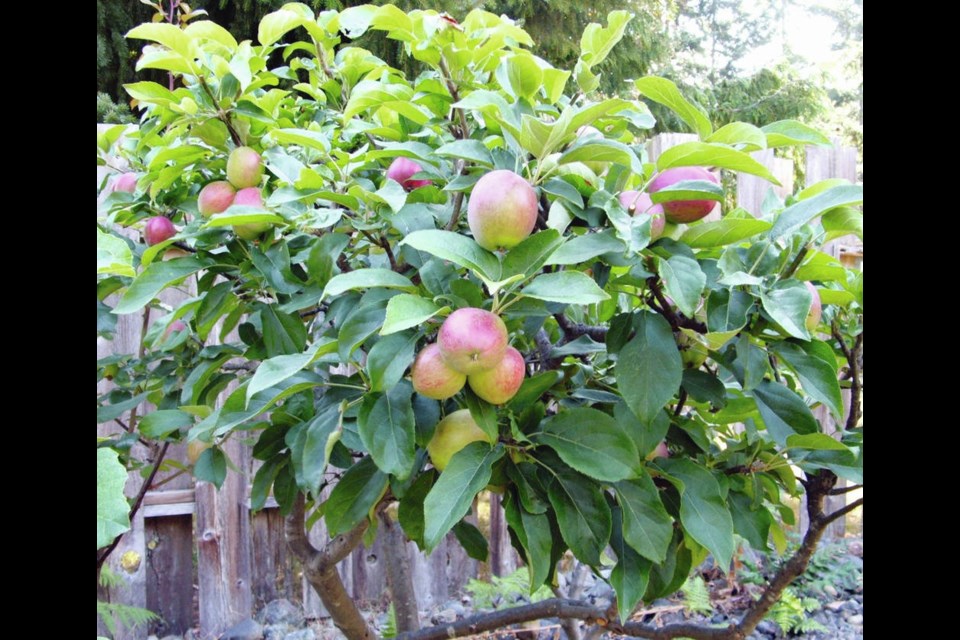Dear Helen: We have an apple tree that has not been pruned for around eight years. It has many, now woody, upright water sprouts. When is the best time to prune, and how much of the excess growth can safely be pruned away at one time?
M.P.
Spread the pruning over three years, not to shock the tree. Start now by removing just a few errant limbs, but be aware that late winter (“dormant”) pruning done too heavily promotes the growth of water sprouts, which grow straight upward and are very vigorous.
In contrast, pruning done in summer helps to keep an apple tree as compact as possible.
To remove one-third of the tree this year, you could begin with a few initial cuts now, followed by one or two prunings in early and mid summer. Then do the same the next year and again the year after that.
Dear Helen: I have tiny slugs in my raised vegetable planter. Last year, slugs remained a problem in the planter all season. I spent hours hand-picking them. I don’t want to use a slug killer, unless there is one that is entirely safe. I have dogs.
J.M.
Slug and snail baits containing an attractant bait and iron do not attract and are non-toxic to pets, earthworms and wildlife. They are available under several brand names. Follow directions carefully for best results.
Slugs proliferate in cool, moist, cloudy conditions. Water only as much as is needed, preferably in the morning to allow the soil surface to dry by evening. Consider setting one or two beer traps in the planter.
Dear Helen: My wife and I have gardened on the same property for 30 years. We are puzzled by the crocus plantings. Almost every year they come up a different colour. What could be happening?
R.E.
A colour change every year in the same crocus planting is a real puzzle. A change among plantings of different flower colours to all one colour usually takes place over several years and is attributed to the strongest variety taking over a planting by shedding seed most vigorously and producing more of its kind.
Crocus seed capsules disperse ripe seeds early in the summer. The seeds germinate the following spring and in four or five years the seedlings develop corms of flowering size.
Though a yearly colour change is odd, it is known that Crocus vernus varieties, commonly referred to as large Dutch crocus, are highly variable in flower colour, which can be easily affected by temperature, as well as by soil and sunlight conditions.
Dear Helen: Our apple tree produces a heavy crop of apples, none of them edible. The skins are speckled with small spots and beneath the spots the flesh is spongy and spoiled. The condition is spread through enough of each apple to render it unusable. The taste is bitter. What is this, and what can be done about it?
M.L.
You have described a condition called bitter pit, It is caused by a calcium deficiency in the developing fruit. That does not necessarily mean that your soil is lacking in calcium. Sometimes the condition arises in a hot, dry summer when the soil becomes lacking in the moisture needed for transporting calcium into the tree.
Lime the soil underneath and around the tree, extending the liming beyond the tips of outstretching branches (the “drip line”).
Water regularly during dry summer weather. Avoid thinning the fruit excessively. Severe thinning tends to produce large apples, which are most prone to developing bitter pit. Another thing to avoid is over-fertilizing with nitrogen.
Dear Helen: As a new gardening season begins, once again I’m about to order a soil or compost product for replenishing my beds. My problem: In the past few years the products delivered, all from different sources, have been contaminated with bits of ground-up plastic and metal. How can I find a source of clean compost for my garden?
A.H.
First, ask neighbours and gardening friends who have soil amendments delivered. Almost always, after a bit of such canvassing, a high-quality source will emerge.
I’d also ask at one or two of your favourite local garden centres. People there usually know who has the best soil amendment products.
Following that research, if you need further confirmation of quality and if this is possible, go to the source and examine the product before ordering.



